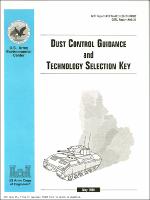Please use this identifier to cite or link to this item:
https://hdl.handle.net/11681/19913Full metadata record
| DC Field | Value | Language |
|---|---|---|
| dc.contributor | U.S. Army Environmental Center | - |
| dc.contributor.author | Gebhart, Dick L. | - |
| dc.contributor.author | Denight, Michael L. | - |
| dc.contributor.author | Grau, Richard H. | - |
| dc.date.accessioned | 2016-10-12T14:03:36Z | - |
| dc.date.available | 2016-10-12T14:03:36Z | - |
| dc.date.issued | 1999-01 | - |
| dc.identifier.uri | http://hdl.handle.net/11681/19913 | - |
| dc.description | Technical Report | - |
| dc.description | Abstract: Allbough considerable research has been conducted by the U.S. Army Engineer Waterways Experiment Station, U.S. Army Construction Engineering Research Laboratory, product manufacturers, and other Federal and State agencies concerning dust control, results from this this body of work have been published in a number of diverse and obscure documents that are largely unavailable or inaccessible to Army environmental, safety, public works and natural resource managers. This lack of readily available information limits the ability of Army environmental, safety, public works, and natural resources managers to make informed, cost effective decisions regarding the selection and application of appropriate dust control products with proven performance characteristics and maintenance requirements. The objective of this work was to produce a sample to use guidance document for dust control on roads, trails, and landing strips which summarizes, to the greatest extent possible, results from previous research that has experimentally documented (1) research site characteristics, (2) chemical composition of dust control products tested, (3) application rates and techniques, and (4) performance, durability, cost, and maintenance requirements. Summarized data was subsequently used to develop a dichotomous key that allows the user to select the most appropriate/environmentally acceptable dust control product based on site specific information such as climate, underlying soil types and textures, trafficked surface and aggregate material characteristics, vehicle type, anticipated traffic volumes, and length of service required. | - |
| dc.publisher | Construction Engineering Research Laboratory (U.S.) | - |
| dc.publisher | Engineer Research and Development Center (U.S.) | - |
| dc.relation | http://acwc.sdp.sirsi.net/client/en_US/search/asset/1032523 | - |
| dc.rights | Approved for public release; distribution is unlimited. | - |
| dc.source | This Digital Resource was created from scans of the Print Resource | - |
| dc.subject | Dust control | - |
| dc.subject | Unsurfaced roadways | - |
| dc.subject | Unsurfaced roads | - |
| dc.subject | Landing pads | - |
| dc.subject | Airfields | - |
| dc.subject | Wheeled vehicles | - |
| dc.subject | Tracked vehicles | - |
| dc.subject | Dust palliatives | - |
| dc.subject | Road construction | - |
| dc.subject | Road maintenance | - |
| dc.subject | Water application | - |
| dc.subject | Water attracting chemicals | - |
| dc.subject | Organic nonbituminous chemicals | - |
| dc.subject | Petroleum based | - |
| dc.subject | Electrochemical | - |
| dc.subject | Polymers | - |
| dc.subject | Soils | - |
| dc.subject | Trails | - |
| dc.title | Dust control guidance and technology selection key | - |
| dc.type | Report | en_US |
| Appears in Collections: | Technical Report | |
Files in This Item:
| File | Description | Size | Format | |
|---|---|---|---|---|
| CERC-TR-99-21.pdf | 9.51 MB | Adobe PDF |  View/Open |